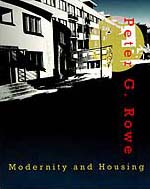Modernity and Housing
 Starting from the question of how the design of modern housing can be successful, Peter Rowe explores the social, cultural, and expressive history of housing at two crucial moments: the first large-scale developments along modernist lines in the 1920s, and the widespread reconsideration of modernist principles in the 1970s. Although the inquiry is conducted along historical and theoretical lines, it proposes to uncover practical principles that may guide the design of modern housing, each principle responding to a contemporary architectural paradox posed by modern conditions. Six detailed case studies form the illustrative centerpiece of the book.
Starting from the question of how the design of modern housing can be successful, Peter Rowe explores the social, cultural, and expressive history of housing at two crucial moments: the first large-scale developments along modernist lines in the 1920s, and the widespread reconsideration of modernist principles in the 1970s. Although the inquiry is conducted along historical and theoretical lines, it proposes to uncover practical principles that may guide the design of modern housing, each principle responding to a contemporary architectural paradox posed by modern conditions. Six detailed case studies form the illustrative centerpiece of the book.
Modernity and Housing embraces three more or less parallel themes concerning modernity: the rise of technocracy and the attendant tendency of modern space to become universal while the experience of time is confined to the present; the problem of representation for a culture in which subject-centered reason has replaced metaphysical foundations; and social practices that give rise to urban concentrations and the production of mass housing on an unprecedented scale.
Within these themes, the modern experience of space and time philosophically grounds discussion of local and traditional versus universal and novel building practices; the perspective of subject-centered reason grounds the exploration of the use of abstract forms and the concomitant problem of providing for an expressive architectural language; and the unprecedented quantities of housing production raise the thorny issue of widely defining a normative building program that allows for local particularity.
The case studies cover Sunnyside Gardens, New York; Romerstadt, Frankfurt-am-Main; Kiefhoek, Rotterdam; the Byker Redevelopment, Newcastle upon Tyne, United Kingdom; Villa Victoria, Boston; and the Malagueira Quarter, Evora, Portugal. An appendix contains an annotated and statistical summary of all major housing projects described in the text, with notes that include the date, size, place, architect, client, housing type, relative densities, and other items of interest.
Contents
- Conditions of Modernity
The Rise and Rearrangement of the Modern Technical Orientation
Time, Space, and Technology
Representation and Modern Forms of Rationality
Normative Programs for Living
Orthodox and Post Modernity
- Modern Housing on the Rise, 1920-1930
Precursors and Contemporary Developments
Postwar Production in Three Nations
Three Projects in Three Cities
A Modern Approach to Housing
- Modern Housing in Crisis and Transition, 1970-1980
Booms and Developments of the Postwar Years
Form, Identity, and a Crisis of Meaning
Three Projects in Three Places
Reformed Modernism
- Situating Modern Housing Architecturally
Being and Becoming
Open-Endedness and Predetermination
Redundancy and Precision
Normalcy and Distinction
Appreciable Abstraction
Projects in the City
Modern Housing In Situ
Appendix A
Profiles of Selected Housing Projects
Appendix B
Profiles of Housing Production
MIT Press